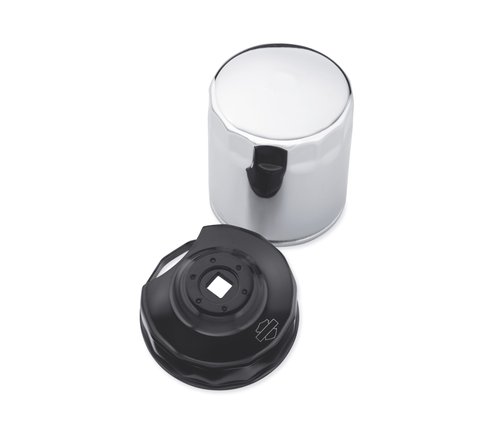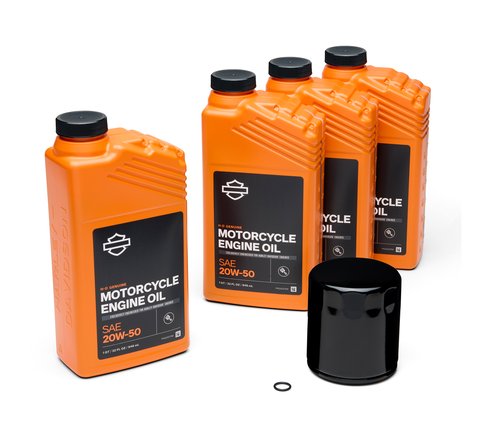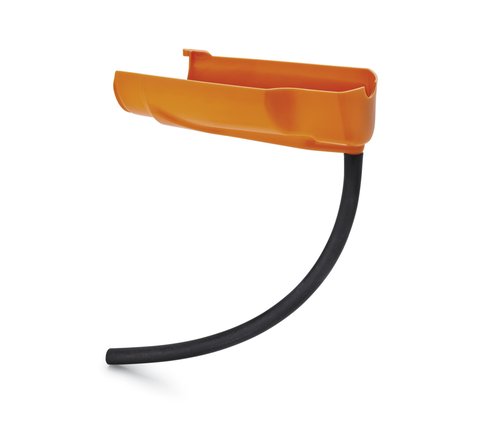A Guide to Motorcycle Oil & Oil Change Basics
Comments CommentMotorcycle oil is critical to the performance of your beloved bike—but do you know why that is? How about what it’s made from?
Fear not—whether you’re new to motorcycle oil or just want to brush up on some of the basics, you’ll find everything you need to know in the guide to that ever-important ingredient: motorcycle oil.
What Is Motorcycle Oil and Why Is It Important?
In short, oil is the lifeblood of your bike’s engine. Oil is not only responsible for lubricating its moving parts, but also for cooling, cleaning, and flushing away the byproducts of combustion.
Motorcycle engines are capable of achieving incredible speeds, but to continue running smoothly—without parts coming into contact with one another and creating friction that can slow the engine down (or, worse, stop it altogether)—the engine relies on the lubrication provided by oil. As it lubricates parts of the engine, oil also carries heat away from and cleans everything it comes into contact with in order to keep the engine in tip-top shape. Because of its importance in improving the function and longevity of a bike’s engine, motorcycle oil should be changed at regular intervals.
Shop Popular H-D Motorcycle Oil products
Motorcycle Oil FAQs
Now that you know what oil’s responsible for, it’s time to learn more about how it does that. Find the answers to some of the most common questions about motorcycle oil below.
What’s in a bottle of motorcycle oil?
The Base Stock of the oil makes up about 75-80% of an oil bottle’s contents. Generally speaking, if it comes from the ground, the oil is a “Mineral Oil.” If it is made in a lab or reactor, it’s a synthetic oil.
The remaining 20-25% of a bottle of motorcycle oil is comprised of what’s called an “Additive Pack.” These ingredients make the oil more effective and are tailored to its application. These powerful additives include:
- Viscosity modifiers: These change the way that oil flows. In a multi-viscosity oil like 20W-50, it allows it to flow like 20 weight oil at start up, and like 50 weight oil at operating temperatures.
- Detergents: These clean the inside of your engine.
- Dispersants: These suspend contaminants like sludge and varnish in the oil so that they can be carried to the filter.
- Buffers: These are included in oil to neutralize acids, as acids can damage an engine’s materials
- Anti-oxidants: These additives prevent sludge and oil-thickening oxidation.
- Corrosion inhibitors: These protect internal components from harmful corrosion.
- Anti-wear additives: These Additive Packs also typically contain various other additives that provide protection against internal wear that happens over time.
How Often Should I Change My Motorcycle Oil?
You should change your motorcycle oil and engine oil filter at the first 1,000-mile service interval and at every 5,000-mile service interval thereafter. If you ride your motorcycle hard, under dusty conditions, or in cold weather, the engine oil and filter should be changed more often. Also, you should always change your engine oil and filter prior to winter storage (or any other extended period of storage) so that the oil is clean and free of contaminants during this period.
WHEN SHOULD I CHANGE MY MOTORCYCLE’S OIL?
In addition to the mileage guidelines covered above, it’s usually wise to change your oil at the start of riding season (if you didn’t change the oil before storing the unit), especially if your motorcycle has been sitting idle for a long period. Oil degrades over time, even if the motorcycle isn't being used. Also, consider an oil change if you’ve been riding in particularly challenging conditions, such as extreme temperatures or dirty, dusty environments in order to keep your bike lubricated and running smoothly.
HOW DO I CHECK MY MOTORCYCLE’S OIL?
Checking your Harley-Davidson’s oil is a quick and easy process. First, ensure the motorcycle is on level ground resting on the jiffy stand. On most Harley® models, you'll find a dipstick on the oil tank. Remove it, wipe it clean, then reinsert it without screwing it back in. Pull it out again to check the oil level, which should be between the minimum and maximum marks.
CAN I CHANGE MY OWN MOTORCYCLE’S OIL?
Absolutely. Changing your motorcycle oil is a relatively straightforward process that most owners can handle with the right tools and a bit of time. It can also be a rewarding experience that deepens your connection to your machine. To simplify your oil change, check out Harley-Davidson® oil change kits.
What’s an Oil Change Kit?
An oil change kit is a package conveniently containing everything required to perform a regular oil change. Harley-Davidson® oil change kits include the required amount of motorcycle oil, an oil filter, and a replacement O-ring. Oil change accessories like fill funnels, drain pans, and filter wrenches are also available.
IS IT EASY TO CHANGE MY MOTORCYCLE’S OIL?
For the most part, yes. It involves draining the old oil, replacing the oil filter, and adding new oil. While it does require some mechanical know-how, many find the process relatively simple, especially after doing it a few times. Plus, it's a fantastic opportunity to become more familiar with your motorcycle.
How to Change your Motorcycle’s Oil:
- Warm up your motorcycle until the engine is at normal operating temperature. Consider going for a short ride—it’s much easier to change your oil when your engine is warm.
- Wipe down the area around your oil filter and drain plug with a clean rag.
- After placing a drain pan under your bike’s drain plug, open the plug to drain your used oil into the pan. Using an oil catcher as well can help you avoid drips onto your bike or your floor.
- Once all oil has drained, use an oil filter wrench to remove the oil filter.
- Clean the oil filter mount flange on your bike in preparation for the new filter. You should also clean up any residual oil in your crankcase or transmission housing.
- Install your new oil filter. To do so, first add a thin layer of clean engine oil to the filter’s gasket. This will help lubricate it. Put the filter into place, then hand-tighten the oil filter one-half to three-quarters of a turn after gasket first contacts filter mounting surface. Do not use your oil filter wrench for installation.
- Install your engine oil drain plug along with a new O-ring. See your Owner's Manual for the correct torque for the oil drain plug. Do not overtighten the plug (this may strip the threads causing engine damage).
- Using a funnel, pour in your new motorcycle oil. Refer to your owner’s manual to find the proper level (and type) of oil.
- Check that your oil levels are correct after warming up your bike again and letting it idle for 1-2 minutes. Use your bike’s dipstick to see whether the oil levels are between the minimum and maximum levels. If so, then you’re all set to hit the road.
HOW MUCH DOES A MOTORCYCLE OIL CHANGE COST AT A DEALER?
The cost of an oil change can vary based on location, type of oil, and the specific model of your motorcycle. You can generally expect a dealer oil change to cost, on average, anywhere from $75 to $225.
What’s the Difference Between Synthetic and Petroleum-based Lubricants? Which is Better?
Group I, II, and III petroleum-based lubricants are derived from oil pumped from the ground, whereas Group IV and V synthetic lubricants are chemically produced in a lab. Petroleum-based lubricants inherit physical components of the source crude oil in the refining process. Meanwhile, synthetic lubricants are custom-formulated to have desired properties for specific purposes, meaning that engineers have complete control of the lubricant from start to finish—down to the molecular level.
Petroleum lubricants have been around for a long time and are effective at lubricating in most conditions, but mineral oil often can’t compete with the purity of synthetic lubricants—especially in extreme conditions. Synthetic oil does a better job reducing wear and resisting breakdown under a wider range of operating temperatures.
What Viscosity Oil Should I Use in My Harley?
The recommended viscosity grade for all temperature conditions is SAE 20W50. Harley-Davidson® offers SAE 20w50 Harley-Davidson® Motor Oil. The SAE 50 H-D® Motorcycle Oil is satisfactory in ambient temperatures of 60 to 80°F, and the SAE 60 H-D® Motorcycle Oil in ambient temperatures above 80°F. SAE 20W50 covers the broadest range of operating temperatures. You can also check your owner’s manual to determine the proper oil grade for your bike’s engine.
Why Should I Use H-D Oil in My Harley?
There are a number of reasons why you should opt for using H-D® motorcycle oil in your Harley bike:
- For starters, no one tests as much as we do. We test on the road, on dynos, and in the lab.
- We accumulate millions of testing miles on our engines and drive trains using only H-D® motorcycle oil.
- We test in the harshest environments, including in the extreme heat of the desert.·
- We test under the most rigorous duty cycles. Accelerated durability testing helps explore the limits of our designs in less time. This is a worst-case scenario for oil.
- We run thousands of hours on dynos.
- We test in the laboratory, sampling and analyzing oil to determine its life and effectiveness during use.
What’s the Difference Between Car and Motorcycle Oil?
In the early days of the combustion engine, car and motorcycle oils were essentially the same. However, this is no longer the case. One key difference is the much smaller sump size on a motorcycle. Motorcycles require much less oil at a given time than a car and typically run hotter than car engines. This means motorcycle oil must be able to work harder without breaking down.
What Happens If You Put the Wrong Oil In?
The severity of the problem typically depends on just how different the incorrect oil you added to a bike is. For instance, if the viscosity of the oil is only minorly different from the correct oil type, it’s unlikely that you will face a severe issue. However, if the oil added is significantly more or less viscous, then it can potentially cause serious damage to your motorcycle. When oil is too viscous for an engine, it will be more difficult to pump—sending oil pressure up and oil flow down. When oil is too thin, it might not be able to lubricate effectively enough, leading to dangerous and potentially damaging metal-on-metal contact. See your Owner's Manual for a list of oil types that are right for your motorcycle.
Changing and maintaining your motorcycle's oil may seem like a small task, but it plays a significant role in supporting your bike’s performance and longevity. Whether you decide to do it yourself or let a professional handle it, regular oil changes are an essential part of motorcycle ownership.
Have another Oil FAQ you want answered? Stop by your local Harley-Davidson® dealer, and they can answer and questions you have regarding motorcycle oil or drop your question in the comments below for a chance to have it answered.






